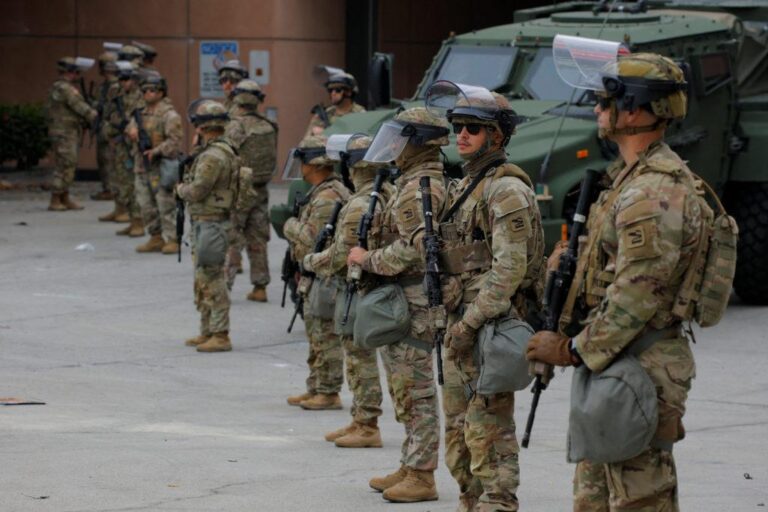Federal Escalation: Additional 2,000 National Guard Troops Deployed to Los Angeles Amid Rising Unrest
Expanded National Guard Presence to Reinforce Security in Los Angeles
In response to intensifying disturbances across Los Angeles, the federal government has approved the deployment of an extra 2,000 National Guard troops to assist local law enforcement. This reinforcement aims to alleviate the strain on city police forces and enhance efforts to safeguard essential infrastructure, enforce curfews, and stabilize public safety during ongoing protests and civil disruptions.
The bolstered troop deployment will concentrate on several critical missions:
- Protecting key public facilities and transit systems
- Supporting police in managing crowds and preventing riots
- Delivering swift responses to emerging conflict zones
- Ensuring continuous operation of emergency services
| Deployment Stage | Number of Troops | Main Responsibilities |
|---|---|---|
| Initial Phase | 1,500 | Patrolling and securing perimeters |
| Augmented Phase | Additional 2,000 | Rapid intervention and infrastructure defense |
| Total Force | 3,500 | Comprehensive enforcement and operational support |
Federal Authorities Highlight Growing Security Threats as Justification for Troop Surge
Officials at the federal level have expressed mounting concerns over the escalation of civil disturbances and the increasing risks posed to Los Angeles’ critical infrastructure. The decision to send an additional 2,000 National Guard members is intended to reinforce local agencies and maintain order amid a climate of heightened tension. These proactive measures are designed to deter violence, protect residents, and secure vital assets.
Federal officials point to several key issues driving this deployment:
- Escalating coordinated protests and confrontations rooted in social and political grievances
- Heightened cyber and physical threats targeting essential infrastructure nodes
- Intelligence indicating organized efforts aimed at disrupting public order
| Security Challenge | Consequences | National Guard Focus |
|---|---|---|
| Civil Disturbances | Threats to public safety and property damage | Crowd management and rapid deployment |
| Infrastructure Vulnerabilities | Service disruptions and sabotage risks | Protection of critical facilities |
| Coordinated Disruption Efforts | Erosion of public confidence | Intelligence gathering and surveillance |
Understanding the National Guard’s Integral Role in Managing Urban Crises and Maintaining Order
The recent augmentation of National Guard forces in Los Angeles highlights their essential function in managing urban emergencies and preserving civil order during periods of unrest. Historically, the Guard’s responsibilities have spanned from logistical support and crowd control to direct intervention when local law enforcement is overwhelmed. Their deployment serves multiple strategic purposes beyond immediate tactical needs:
- Enhancing law enforcement capabilities to maintain public safety in volatile environments
- Providing rapid response teams to defend critical infrastructure and public assets
- Facilitating coordination among city,state,and federal agencies
- Supporting evacuation efforts and emergency medical operations when required
Nonetheless,deploying military forces in densely populated urban areas presents challenges,including managing public perception and safeguarding civil liberties. Transparent communication and carefully defined engagement protocols are vital. The table below summarizes typical National Guard roles and their impact during city-wide emergencies:
| Operational Function | Effect on Urban Crisis Management |
|---|---|
| Security Patrols | Discourages violence and secures key locations |
| Checkpoint Operations | Regulates access to stabilize affected neighborhoods |
| Logistical Support | Maintains supply chains for emergency responders |
| Communication Coordination | Serves as liaison between agencies and the public |
Strategies for Enhanced Collaboration Between Federal and Local Authorities to Safeguard Communities
Ensuring public safety in major metropolitan areas requires seamless cooperation and resource sharing between federal and local entities. Implementing joint training programs and integrated intelligence platforms can significantly improve preparedness and response efficiency. Real-time data exchange enables both National Guard units and municipal law enforcement to anticipate potential flashpoints and deploy resources swiftly, minimizing harm to civilians.
Moreover, fostering community engagement is crucial to building trust and cooperation between residents and security forces. Federal involvement should prioritize strengthening local capabilities rather than replacing them, respecting local governance and decision-making. The following table outlines key collaboration areas that can enhance public safety outcomes:
| Area of Focus | Federal Responsibilities | Local Responsibilities | Anticipated Outcome |
|---|---|---|---|
| Resource Allocation | Deploy National Guard personnel and equipment | Identify critical zones and prioritize deployment | Targeted and efficient reinforcement |
| Communication Systems | Establish secure communication networks | Maintain local command and control protocols | Clear, coordinated messaging and operations |
| Community Outreach | Support inclusive engagement initiatives | Collaborate with neighborhood leaders and residents | Improved public trust and cooperation |
Conclusion: Federal Support Reinforces Los Angeles’ Efforts to Restore Stability
As the additional 2,000 National Guard troops mobilize in Los Angeles, officials underscore the critical importance of reestablishing order amid ongoing unrest. This federal intervention demonstrates a commitment to backing local authorities and safeguarding public welfare during a turbulent period for the city. Authorities will continue to monitor developments closely, adapting strategies as the situation evolves to ensure the safety and security of all residents.




